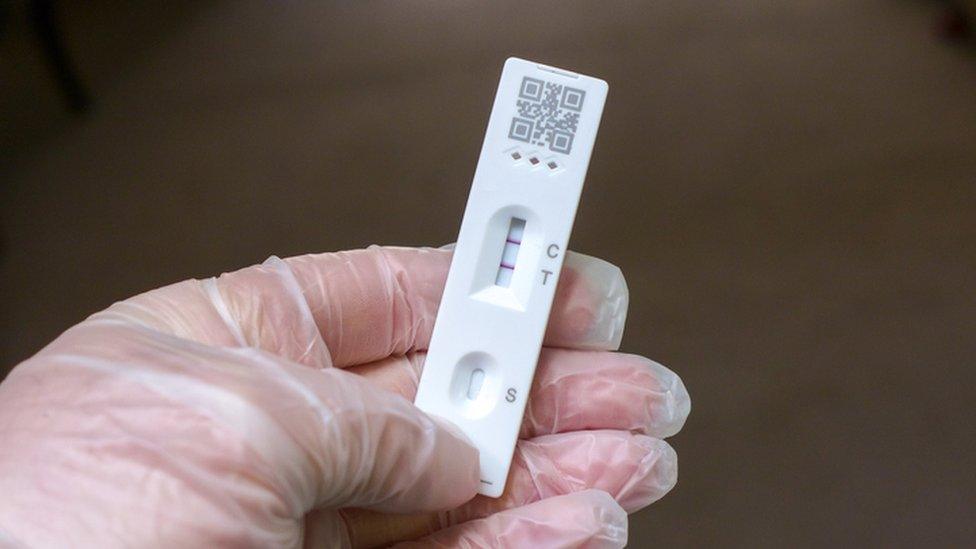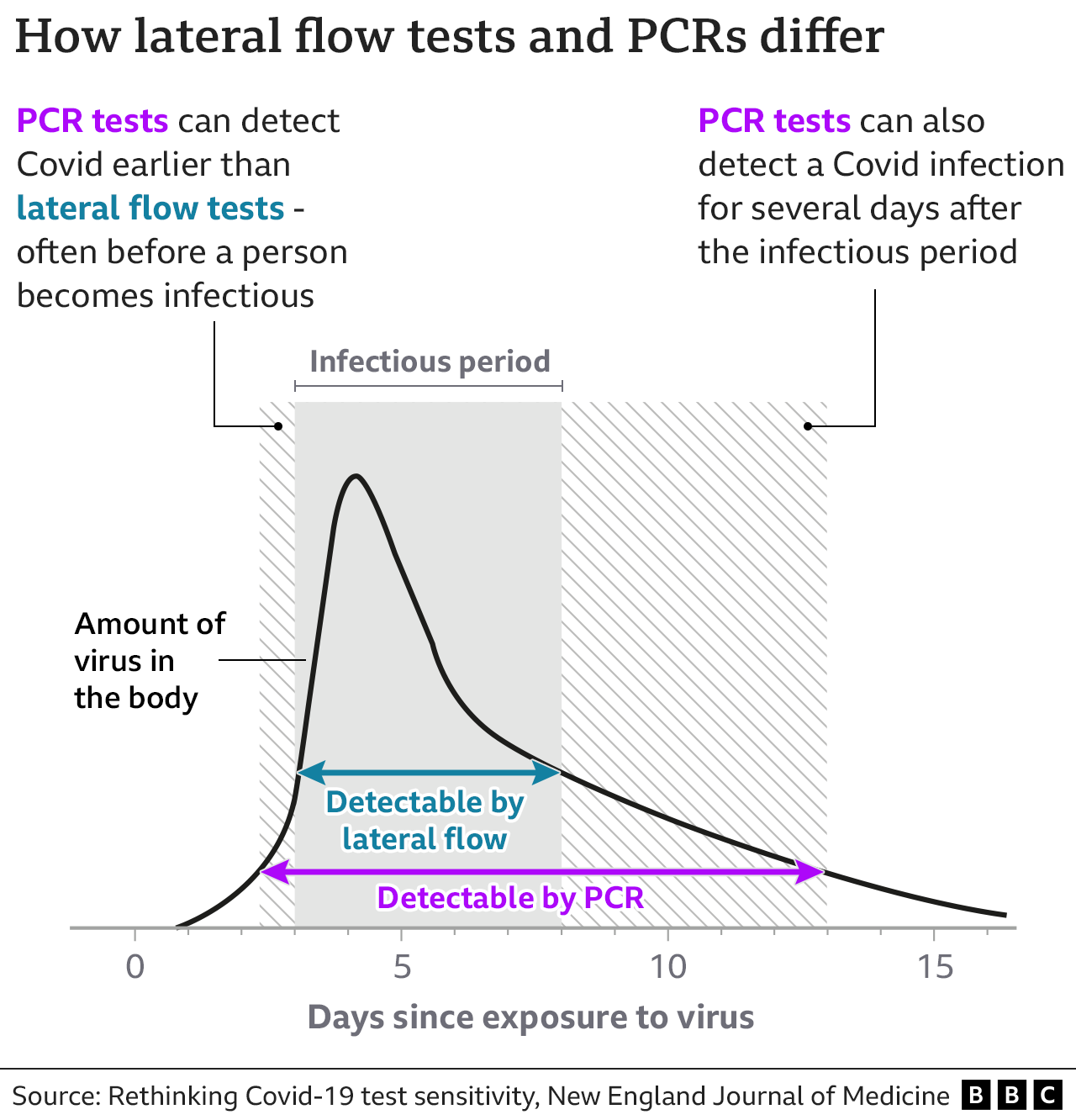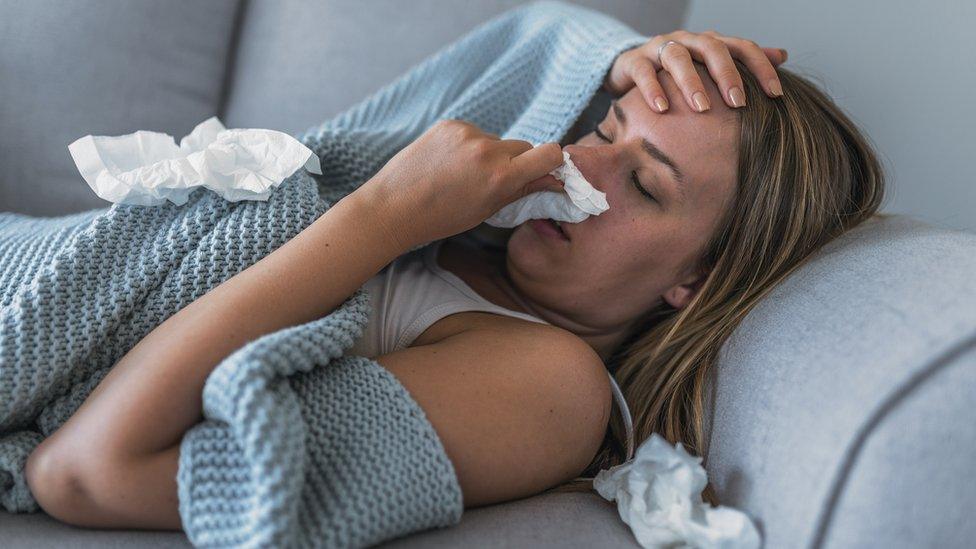Covid-19: What are NI's testing and isolation rules?
- Published

As Northern Ireland's Covid-19 rules and guidance continue to change, BBC News NI examines the remaining advice around testing and self-isolation.
From 22 April, there have been developments with regards to testing sites, contact tracing and advice for household contacts of positive cases.
What is the guidance around testing?
Testing sites across Northern Ireland closed on 22 April, with the requirement ending for symptomatic people to take a polymerase chain reaction (PCR) test.
Instead, people displaying Covid symptoms are advised to take a lateral flow test (LFT).
These will continue to be available free from more than 500 pharmacies, or through online orders.
However, people without symptoms are no longer advised to take LFTs, except in some limited circumstances.
For instance, those providing close personal care at home, or visiting high risk settings such as a hospital, a care home or a hospice, are still advised to take a LFT.

People who have been advised to take tests by health professionals, or those eligible for Covid-19 treatments who develop symptoms, are also advised to take LFTs.
The Department of Health has asked that everyone who takes a LFT should report their result, external.
PCR testing will still be available if you are advised by a healthcare professional to take a PCR test., external
Access to PCR for the small group who remain eligible for PCR testing will be via the home ordering service. , external
What if I am a close contact of a positive case?
The contact tracing service, which was provided by the Public Health Agency in Northern Ireland, has shifted its focus to providing advice to positive Covid cases and their household.
The provision for the wider community ended on 22 April.
Household contacts will be advised to be aware of symptoms and to avoid close contact with individuals at higher risk.
Both vaccinated and unvaccinated household contacts must take a lateral flow test if symptoms develop to ascertain if they too are positive.
Health officials have advised that providing ventilation, cleaning surfaces, washing hands and spending as little time as possible in shared spaces, such as kitchens, bathrooms and sitting areas, are advice to limit the spread of the virus among a household.
How long do I need to isolate for?
Following a positive LFT result, the guidance is that the person should self-isolate for up to 10 days, either from the date of the test or when symptoms started, whichever is sooner.
However, this period can end early, if the person has two negative LFT results taken 24 hours apart, with the first taken no earlier than day five.
Daily tests are advised if this is not met until there have been two consecutive tests taken 24 hours apart.
Health officials advise that people should continue their self-isolation if they still have a high temperature, until this has returned to normal for a 48-hour period.
Those who leave isolation on or after day six are advised to limit contact with people who are at high risk and not to visit a hospital or healthcare setting.
What if I still test positive after 10 days?
If someone's lateral flow tests continue to be positive and they have completed 10 full days of isolation, they do not need to take any more LFTs after day 10 and may leave isolation the following day.
If someone is concerned, they may choose to limit close contact with other people, especially those who are at higher risk of severe illness until 14 days after the start of their self-isolation period.
What are the symptoms of Covid-19?
In Northern Ireland, the executive lists the following as Covid symptoms:
a high temperature
a new, continuous cough
a loss of or change in sense of smell or taste
However, the Department of Health in NI said in April that Covid-19 symptoms may not be limited to just fever, new continuous cough or loss of sense of smell or taste.
It follows the official list of symptoms being expanded to include nine more signs of a coronavirus infection.
The UK Health Security Agency's updated guidance, external now lists symptoms including a sore throat, muscle pains and diarrhoea.
How reliable are the latest Covid-19 figures?
The Covid-19 dashboard published by the Department of Health features the latest statistics on the number of deaths linked to the virus, case numbers and hospital figures.
Since 5 January, people in Northern Ireland who tested positive using a LFT no longer needed to take a PCR test to confirm the result.
The department has asked people who test positive on a LFT to record their result, however, these changes have led to some confusion about the true number of positive cases in Northern Ireland.
In March, BBC News NI reported that daily cases could be as high as 20,000, at a time when the department's figures indicated it was about 2,500.
The department's number of deaths do not necessarily refer to the previous 24 hour reporting period, while the Northern Ireland Statistics and Research Agency (Nisra) has published different numbers on a weekly basis, which focus on deaths where the virus was included on a death certificate.
The department's hospital figures show the number of patients at any time who are being treated in hospital while testing positive, with a separate number showing how many Covid-positive patients are in intensive care.
The department's dashboard can continue to be found here, external.
Use the form below to send us your questions and we could be in touch.
In some cases your question will be published, displaying your name, age and location as you provide it, unless you state otherwise. Your contact details will never be published. Please ensure you have read the terms and conditions.
If you are reading this page on the BBC News app, you will need to visit the mobile version of the BBC website to submit your question on this topic.
Related topics
- Published9 January 2022

- Published5 April 2022

- Published8 January 2022
